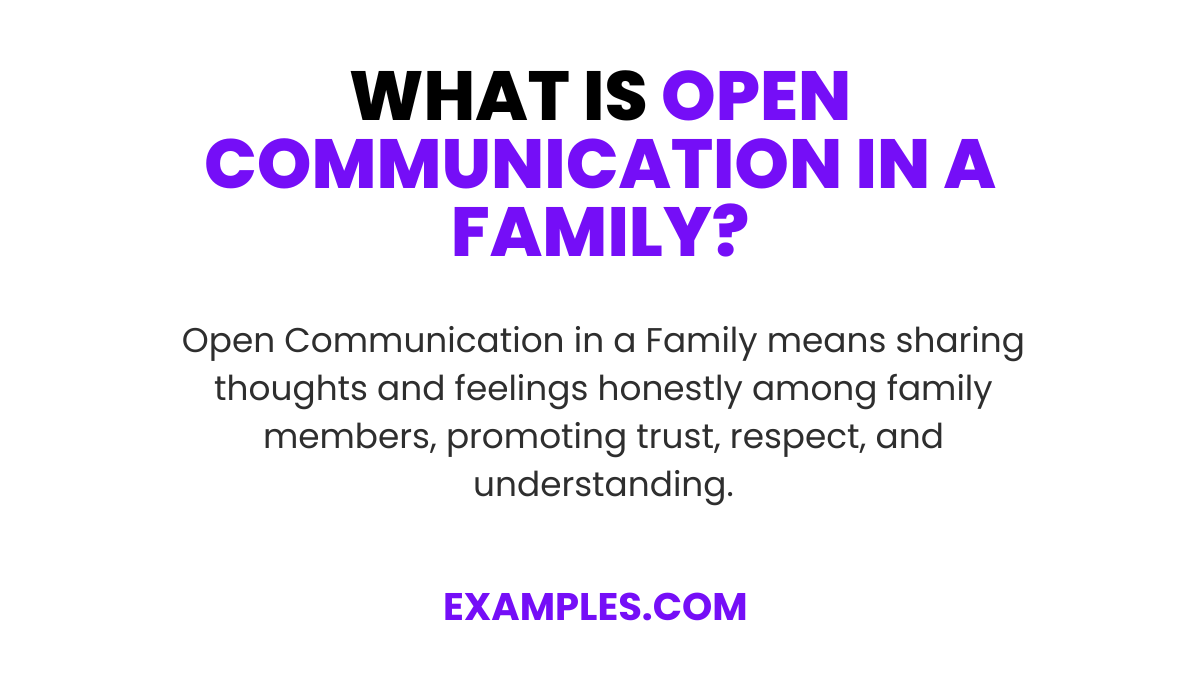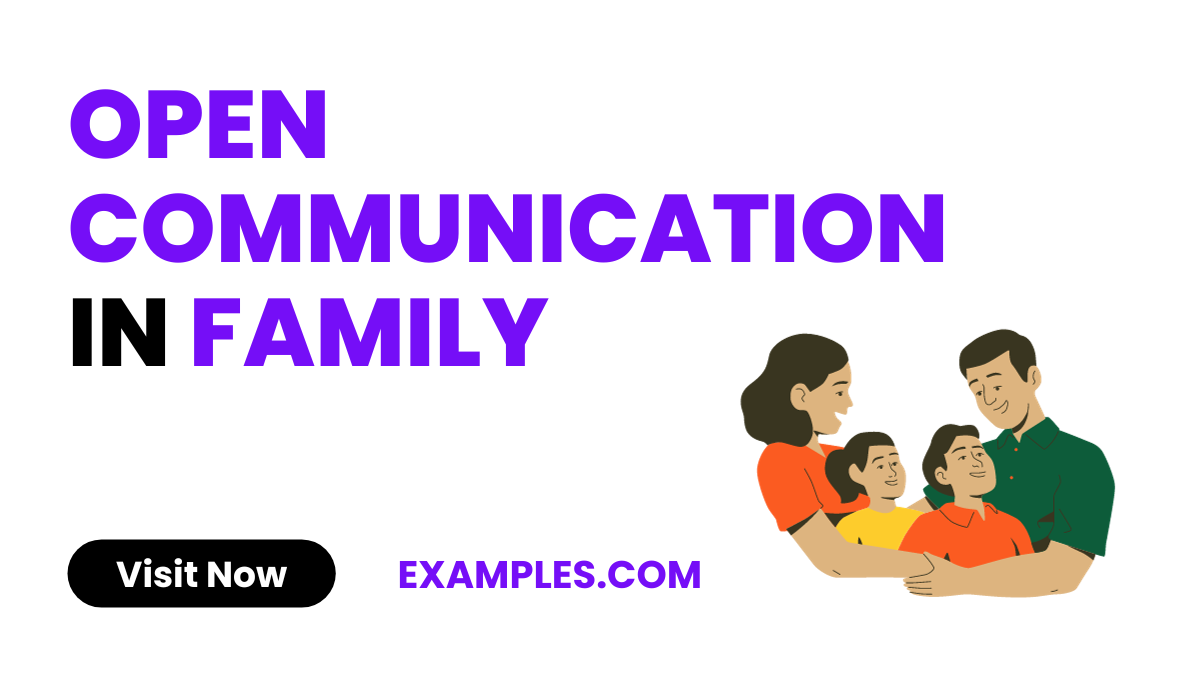7+ Open Communication in Family Examples
Embrace the essence of family unity with a complete guide to Open Communication in Family. Learn through various Communication Examples how open, honest dialogue can strengthen familial bonds, resolve conflicts, and build a nurturing home environment. This guide will walk you through practical strategies and insights to enhance the way your family interacts and understands each other, fostering a loving and supportive atmosphere.
Download Importance of Open Communication in Family Relationship PDF
What is Open Communication in a Family? – Meaning

Open Communication in a Family refers to the practice of sharing thoughts, feelings, and information freely and honestly among family members. It’s a two-way street where listening is as important as speaking. This type of communication is characterized by trust, respect, and a willingness to understand each other’s perspectives. It plays a crucial role in strengthening relationships, solving problems together, and maintaining a healthy, supportive family dynamic where each member feels valued and heard.
How can Parents Promote Open Communication in Family Dynamics?
Promoting open communication within family dynamics is crucial for nurturing a healthy and supportive environment. It allows for better understanding and closer Open Communication in Relationship among family members. To foster an environment of Open Communication in Leadership within the household, parents can follow these steps:
- Lead by Example: Parents should demonstrate Open Communication with Parents by sharing their thoughts and feelings openly with each other and with their children. This sets a positive example and encourages children to do the same.
- Create a Safe Space: Establish a family culture where everyone feels safe to express their thoughts and feelings without fear of judgment. This means respecting each other’s opinions and listening actively.
- Encourage Regular Family Meetings: Hold regular family meetings to discuss various topics, giving everyone a chance to speak. This structured approach can be a great way to ensure that each member, especially children, feels heard.
- Teach Emotional Vocabulary: Help children articulate their feelings by teaching them an appropriate emotional vocabulary. This step is vital in fostering open communication with child, as they often need guidance to express what they are feeling accurately.
- Be Available and Approachable: Ensure that as a parent, you are approachable and available to discuss anything your child needs. Whether it’s a problem at school or a personal dilemma, they should feel they can come to you.
How can Open Communication in Family Life Positively Impact Children’s Development?
Open communication in family life is a bedrock for healthy development, providing children with confidence and security. It shapes their social, emotional, and cognitive growth. Here are five impacts of open communication on children’s development:
- Enhanced Social Skills: Regular family interaction and open communication with colleagues and peers modeled at home help children develop better social skills. They learn to listen, share, and resolve conflicts amicably.
- Emotional Intelligence: When parents engage in open communication with child, it fosters emotional intelligence. Children learn to understand and manage their emotions, leading to better relationships and mental health.
- Academic Success: Children who have open lines of communication with their parents tend to perform better academically. Open communication with students helps them feel supported and understood, boosting their confidence and motivation.
- Healthy Coping Mechanisms: Open dialogue about challenges and feelings helps children develop healthy coping mechanisms. They learn to verbalize their problems and seek support instead of resorting to negative behaviors.
- Trust and Security: Maintaining open communication with parents builds trust and security. Children feel valued and understood, which is essential for their self-esteem and future relationship-building.
What Strategies can Families Employ to Address Conflicts through Open Communication?
Open communication is a critical strategy for resolving conflicts within families, fostering understanding, and building stronger relationships. It involves actively listening, expressing emotions constructively, and seeking mutually beneficial solutions.
1. Establish a Safe Environment: For open communication to thrive, families need to create a safe space where all members feel comfortable and secure in expressing their thoughts and feelings without fear of judgment or reprisal. This safe environment encourages everyone to speak up and contributes to effective conflict resolution.
2. Active Listening: Encourage every family member to practice active listening. This means giving undivided attention to the speaker, refraining from interrupting, and responding thoughtfully. Active listening helps in understanding the perspective of others and aids in resolving conflicts more amicably.
3. Use “I” Statements: Teach family members to use “I” statements when communicating, such as “I feel” or “I think.” This approach shifts the focus from blaming to expressing personal feelings and reduces the defensive reactions in heated discussions.
4. Seek Mediation: Sometimes conflicts can be too complex to handle within the family. In such cases, seeking external help from a mediator or a counselor can be beneficial. Professionals can facilitate open communication with stakeholders, guiding the family towards resolution.
5. Regular Family Meetings: Establish a routine of having regular family meetings to discuss any issues or conflicts that have arisen. This ensures that issues are addressed promptly and do not escalate. Encourage honesty and openness in these discussions.
Why is Trust Important for Family Open Communication?
Trust is the cornerstone of any relationship, and it is incredibly vital for open communication in families. Without trust, family members may feel hesitant to share their true feelings or discuss sensitive issues, fearing negative repercussions or misunderstandings.
1. Fosters Honesty: Trust encourages honesty in conversations. When family members trust each other, they are more likely to share their genuine thoughts and feelings. This honesty is crucial for resolving conflicts and understanding each other’s perspectives.
2. Reduces Fear of Judgment: With trust, individuals feel that their family members will not judge or criticize them harshly for their thoughts or mistakes. This assurance makes it easier to communicate openly and address issues before they escalate.
3. Encourages Vulnerability: Trust allows family members to be vulnerable with each other. Sharing vulnerabilities is a powerful way to deepen connections and foster empathy, making it easier to navigate through conflicts and misunderstandings.
4. Strengthens Relationship Bonds: Trust builds stronger relationships. As trust grows, so does the bond between family members, creating a supportive and nurturing environment conducive to open communication.
5. Enhances Problem-Solving: Trust in relationships contributes to more effective problem-solving. When there is trust, family members are more likely to collaborate and find creative solutions to conflicts, knowing that everyone’s best interests are being considered.
By integrating strategies such as creating safe spaces, active listening, and fostering trust, families can significantly improve their ability to resolve conflicts through open communication. Emphasizing the Importance of Open Communication in Relationship and in the broader context of life, including Open Communication in the Workplace, is beneficial for all family members to understand and appreciate the value of these skills in every aspect of their lives.
What are the Key Benefits of Fostering Open Communication in Family Relationships?
Fostering Open Communication Benefits enhances trust, resolves conflicts, and strengthens bonds, highlighting the Importance of Open Communication for healthier, happier family dynamics.
What are Common Challenges in Establishing Family Open Communication?
Challenges include overcoming past communication patterns, managing emotional reactions, and ensuring everyone’s commitment to Honest Communication and understanding.
What is the Best Way to Keep Communication Open with Families?
Regular, honest discussions, active listening, and empathy are crucial. Embrace How to Promote Open Communication and appreciate diverse viewpoints for a robust family dialogue.
Open communication in families fosters understanding and unity, bridging gaps and resolving conflicts. Embracing open communication vs closed communication and direct communication leads to healthier relationships. Utilize open communication quotes for inspiration and consider its significance in all areas, including Open Communication in Healthcare, to appreciate and implement effective dialogue in family life.



